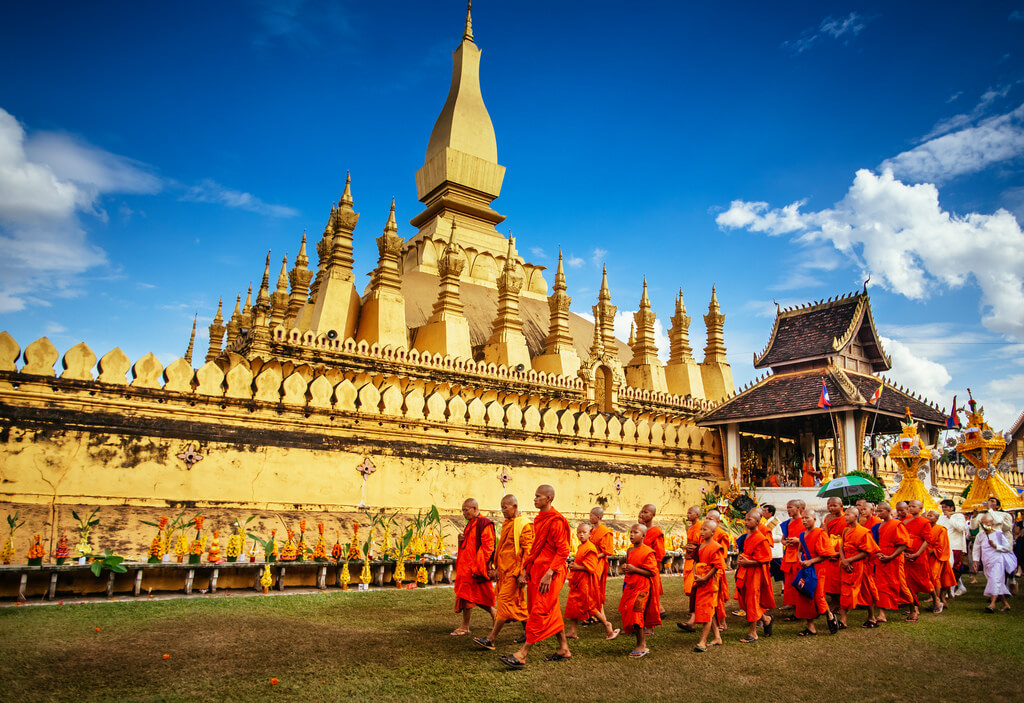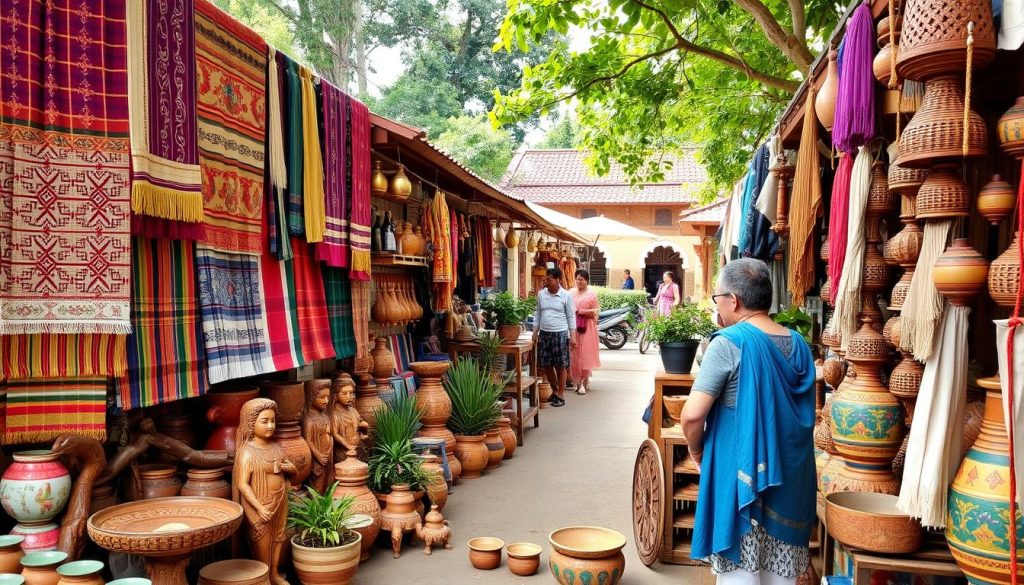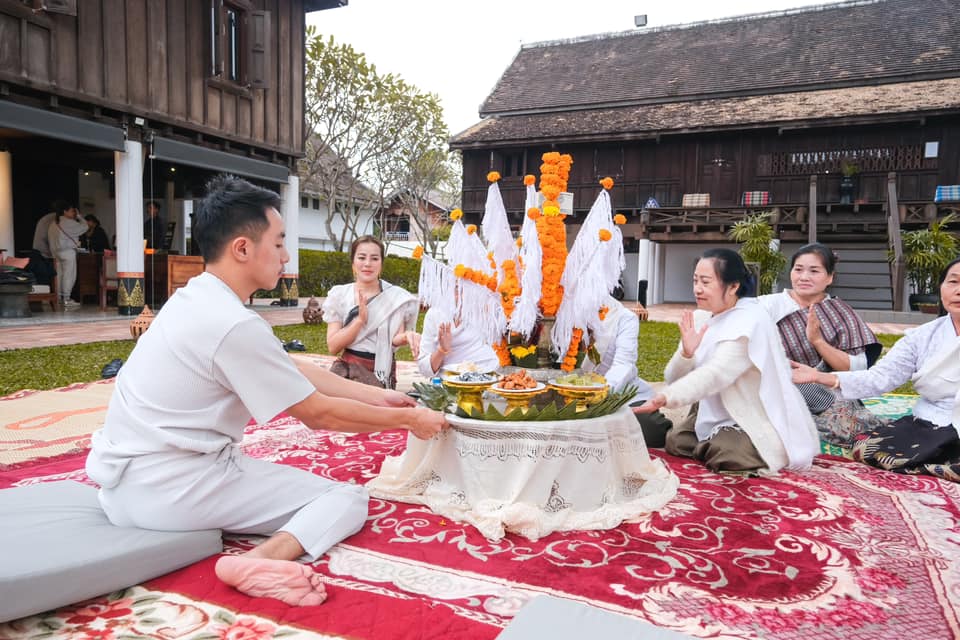1. Overview
Vientiane is home to several traditional villages that offer a glimpse into the rich cultural heritage and daily life of Laos. These villages are nestled within scenic landscapes and offer experiences that include traditional handicrafts, farming practices, and unique customs. Exploring these villages gives visitors a deep cultural connection to Laos’ rural communities.
- Name: Traditional Villages around Vientiane
- Location: Various villages near Vientiane, such as Ban Pako, Ban Keun, and fishing villages along the Mekong River
- Coordinates: Vary by village, typically around 17.9° N, 102.6° E for central Vientiane
- Best visited: As part of a guided tour or day trip
2. History of the Place
These villages represent the diverse ethnic groups that inhabit Laos, including the Hmong, Khmu, and Lao people. The villages have been central to sustaining Laos’ agricultural economy and traditional way of life for centuries. Visitors to these villages learn about traditional living, food production, and local customs.
- Ban Pako Village: Established in the 1800s, this village is known for its eco-lodges and cultural preservation
- Hmong & Khmu Villages: These ethnic groups maintain unique housing styles and agricultural practices
- Mekong River Villages: Villages along the Mekong River practice traditional fishing techniques
- Ban Thieng Village: Known for its river-based culture and rural lifestyle
- Salt Extraction Villages: Ban Keun and Ban Bo are famous for traditional salt harvesting methods
- Traditional Handicrafts: Local villagers craft baskets, textiles, and pottery using centuries-old methods
- Cultural Festivals: Villages host traditional festivals, reflecting Laos’ animist beliefs and Buddhism
- Agricultural Roots: Villagers rely on rice farming and animal husbandry for sustenance
- Buddhist Influence: Many villages maintain Buddhist traditions with local shrines and rituals
3.Location
4. What Makes “Traditional Villages” Popular? + Recommended YouTube Video
The traditional villages near Vientiane are popular for offering authentic cultural experiences. Visitors can participate in local activities like fishing, salt extraction, or weaving, and observe the community’s agricultural lifestyle. The serene rural settings, rich history, and unique customs make these villages ideal for cultural exploration.
- Authentic Experiences: Engage in traditional activities like fishing and farming
- Rich Cultural Heritage: Learn about Laos’ diverse ethnic communities
- Scenic Beauty: Picturesque villages set against lush landscapes
- Local Crafts: Purchase handmade goods directly from villagers
5. Overall Ratings (1 to 5 Stars)
The traditional villages near Vientiane receive high ratings for their cultural authenticity and peaceful environment. Visitors appreciate the opportunity to connect with local communities and gain insight into rural life in Laos. While accessibility can be challenging for some villages, the experience is highly rewarding.
- Overall Rating: ★★★★☆ (4.5/5)
- Cultural Significance: ★★★★★ (5/5)
- Authenticity: ★★★★★ (5/5)
- Atmosphere & Environment: ★★★★☆ (4/5)
- Accessibility: ★★★☆☆ (3/5)
- Tourist Friendliness: ★★★★☆ (4/5)
6. Weather
The weather in Vientiane is tropical, with a distinct wet season and dry season. The dry season from November to February is ideal for visiting the traditional villages, offering clear skies and moderate temperatures. The wet season can make travel more challenging, especially in rural areas.
- Best Time to Visit: November to February (dry season)
- Temperature Range: 25°C to 30°C (77°F to 86°F)
- Wet Season: May to October (frequent rainfall)
- Travel Considerations: Prepare for mud and rain during the wet season
7. Nearest Five Hotels
Staying in Vientiane gives visitors access to these villages via day trips or guided tours. The following hotels are centrally located and offer easy access to transportation for visiting the traditional villages:
- Sabaidee@Lao Hotel: Comfortable, modern amenities, centrally located
- City Inn Vientiane: A budget-friendly option with good service
- Lao Plaza Hotel: Upscale hotel with luxurious facilities
- Vientiane Garden Hotel: Quiet, scenic hotel near the city center
- Ibis Vientiane Nam Phu: Convenient and affordable hotel in the heart of the city
8. Timings
The traditional villages are generally open during daylight hours. If visiting as part of a tour, specific hours will be arranged. The best times to explore are early mornings or late afternoons when the weather is cooler and the atmosphere is more peaceful.
- Opening Hours: Typically 8:00 AM – 5:00 PM
- Best Time to Visit: Early morning or late afternoon for a more relaxed experience
- Tours Available: Often part of full-day or half-day tour packages
9. Time Required to Visit
A typical visit to a traditional village near Vientiane lasts around 3 to 4 hours, depending on the village and the activities you choose to participate in. If you plan to visit multiple villages or participate in hands-on activities, such as salt extraction or fishing, plan for a full day.
- Short Visit: 1–2 hours for sightseeing
- Extended Visit: 3–4 hours for more cultural immersion
- Full-Day Tours: Can include multiple village visits
10. Entry Fees & Ticket Booking Details
There is often a small fee to visit the traditional villages, which helps support local community projects. Some villages, such as those where salt is extracted or fishing techniques are demonstrated, may charge additional fees for participation in activities.
- Entry Fee: Varies by village, typically around 5,000 to 10,000 Kip
- Booking: Not always required for self-guided visits; tours can be booked in advance
- Activity Fees: Additional charges for participating in local activities (e.g., fishing, salt harvesting)
11. Things to See & Do
Visiting a traditional village offers a variety of cultural experiences. Depending on the village, you may engage in activities like fishing, salt harvesting, weaving, or learning about local agriculture. Each village has its own unique way of life that visitors can witness firsthand.
- Fishing: Participate in or observe traditional fishing techniques along the Mekong
- Salt Harvesting: Watch or try the traditional salt extraction process
- Handicrafts: Learn about and purchase handmade crafts from local artisans
- Cultural Customs: Experience daily life, including farming, cooking, and communal rituals
12. Best Time to Visit
The best time to visit is during the dry season when the weather is cooler, making outdoor activities more comfortable. Early morning visits offer cooler temperatures and less crowded conditions, while late afternoons provide a peaceful atmosphere.
- Best Season: November to February (dry and cooler weather)
- Best Time of Day: Early morning or late afternoon
- Avoid: Wet season (May to October) due to potential rain and mud
13. Nearest Parking Spots
Parking is available near most of the villages, but it may be limited, especially in smaller, more rural locations. If traveling as part of a guided tour, transportation will be provided. For those exploring independently, tuk-tuks or bicycles are popular options.
- Street Parking: Limited at some village entrances
- Tuk-Tuk: Convenient for short trips
- Bicycle Rentals: Ideal for local exploration
14. Tips for Visitors
When visiting traditional villages, it’s important to respect local customs and traditions. Dress modestly, ask for permission before taking photographs of villagers, and be mindful of the peaceful atmosphere. Bring sun protection, and if you’re traveling to rural areas, ensure you have water and snacks.
- Dress Modestly: Respectful attire is important in rural and cultural settings
- Photography: Ask for permission before taking photos of people
- Stay Hydrated: Bring water, especially during the hot season
- Support Local Economies: Purchase crafts or participate in local activities
15. How to Reach the Place
Traditional villages near Vientiane are easily accessible by car, tuk-tuk, or bicycle. Many visitors take day trips, and guided tours often include transportation to and from the villages. For more remote villages, it may be best to travel with a local guide who knows the area.
- By Tuk-Tuk: Convenient and widely available
- By Bicycle: Popular option for city exploration
- By Car: Accessible by rented car or taxi
- Guided Tours: Best for more distant villages
16. Nearby Attractions to Combine for the Visit
There are several nearby attractions that can be combined with a visit to the traditional villages of Vientiane. Many travelers visit the city’s cultural landmarks and then head out to the villages for a deeper look at local life.
- Patuxai: A victory monument offering panoramic city views
- Presidential Palace: An iconic government building with historical significance
- Mekong Riverside: Scenic views and a local market
- Wat Si Saket: The oldest temple in Vientiane, filled with history
- That Dam: The mysterious “Black Stupa” with local legends



